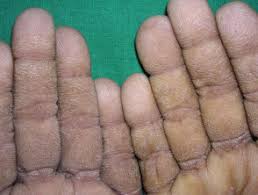 Tripe palms is a cutaneous condition characterized by ridged velvety lesions on the palms resembling the lining of a cow’s stomach.
Tripe palms is a cutaneous condition characterized by ridged velvety lesions on the palms resembling the lining of a cow’s stomach.
Other name is Acanthosis palmaris.
It is a paraneoplastic process.
Tripe palms are a very rare skin condition affecting the palms of hands and soles of feet.
Tripe palms are characterized by thickened skin resembling the stomach lining of some animals.
Tripe palms, also known as acanthosis palmaris or acquired pachydermatoglyphia.
They are are frequently associated with internal malignancy.
Tripe palms are a paraneoplastic dermatosis; a group of skin conditions that are caused by cancer and share the same underlying genetic basis. It often coexists with acanthosis nigricans.
There are approximately 100 cases of tripe palms reported in medical literature.
It is more common in males than in females.
Approximately 90% of cases of tripe palms are associated with internal malignancy.
Skin changes may precede the diagnosis of, or develop during, malignancy.
Tripe palms has also been associated with non-cancerous conditions such as:
Bullous pemphigoid
Psoriasis
Exfoliative dermatitis.
It is proposed that the cancer cells secrete growth factors, such as epidermal growth factor-α and transforming growth factor-α, causing growth of skin cells (keratinocytes) and result the appearance of tripe palms.
Cancers that have frequently been associated with tripe palms include:
Gastric cancer
Lung cancer
Breast cancer
Genitourinary tract cancers
Patients with tripe palms present with thickened skin on the palms of their hands, that can accentuate dermatoglyphic change which appears as a velvety pattern.
The thickening often gives a yellow hue to the skin.
The soles of feet can also be affected.
Tripe palms usually coexists with malignant acanthosis nigricans in approximately 7 of 10 cases.
Acanthosis nigricans describes the darkening and velvety appearance of body folds, such as the neck, armpits, and groin.
Tripe palms can be found alongside:
Clubbing of the fingernails, 1 in 5 persons.
Itchiness of the skin, 1 in 4 persons
Cutaneous papillomatosis
Multiple fast growing seborrhoeic keratosis (sign of Leser-Trélat).
Tripe palms are diagnosed clinically.
What is the differential diagnosis for tripe palms:
The clinical appearance of tripe palms can be like:
Acrokeratosis paraneoplastica
Acromegaly
Hypertrophic pulmonary osteoarthropathy
Pachydermoperiostosis
Palmoplantar keratoderma
Thyroid acropachy.
Patients presenting with tripe need to be worked up for malignancy.
Management with oral retinoids have helped.
Approximately 3 out of 10 cases of tripe palms resolve when the underlying cancer is managed
Tripe palms may persist despite remission of the underlying cancer.
